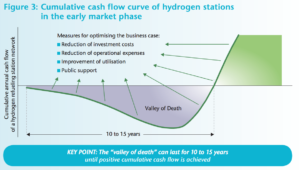IEA calls for renewable hydrogen and carbon-free ammonia
By Trevor Brown on April 21, 2017
This week, an important new voice joined the chorus of support for renewable ammonia and its potential use as an energy vector – the International Energy Agency (IEA).
In his article, Producing industrial hydrogen from renewable energy, Cédric Philibert, Senior Energy Analyst at the IEA, identifies a major problem with the hydrogen economy: hydrogen is currently made from fossil fuels. But his argument for producing hydrogen from renewable energy leads almost inevitably to ammonia: “In some not-too-distant future, ammonia could be used on its own as a carbon-free fuel or as an energy carrier to store and transport energy conveniently.”
Producing hydrogen via renewable energy is not a new idea. Until the 1960s, hydrogen from hydropower-based electrolysis in Norway was used to make ammonia – a key ingredient for agricultural fertilizers. But low gas prices and the emergence of SMR meant this technology became less fashionable during an era when carbon emissions were not a consideration.
But with increasingly lower renewable costs, renewables-based hydrogen production could once again be competitive with SMR.
IEA, Producing industrial hydrogen from renewable energy, 04/18/2017
Philibert draws two conclusions from the IEA’s vast wealth of energy data for his assessment of hydrogen and ammonia.

First, the price of electricity in renewable resource-rich areas has already reached a level at which electrolyzers are competitive with other low-carbon technologies: “Newly built wind farms in Morocco, and solar plants in Dubai and Chile, where electricity costs are around $30/MWh, could also be competitive with SMR paired with carbon capture and storage.”
Second, price alone isn’t enough to make these projects succeed – they must also take advantage of that low price by using large amounts of that power to recoup the high capital expenses of the electrolyzers: “To be competitive, the electroylzers would have to have relatively high utilization factors – that is, they would have to run for several thousand hours per year.” And these higher utilization rates will be achieved in locations where renewable power is constant – like geothermal – or where more than one type of renewable is available – like solar and wind, together.
Under the right conditions, producing industrial hydrogen in this fashion could have massive consequences for the sustainability of one industry in particular – agriculture. About half of industrial hydrogen is used in ammonia production. Ammonia production alone is responsible for about 360 million tonnes of CO2 emissions each year, or about 1% of the world’s total emissions. By 2050, we expect that the consumption of ammonia will increase by around 60%.
Places that meet these two conditions – low prices and a high utilization factor – could be found in sunny, windy regions with the right combination of solar plants and wind farms. Based on extensive wind and solar geospatial data, preliminary analyses reveal a number of large areas with this combination.
IEA, Producing industrial hydrogen from renewable energy, 04/18/2017
This is not, therefore, a vision for integrating more renewables into the grid by using ammonia for energy storage, as some projects have proposed. It is instead a broader vision that seeks to add significant new renewable power supply in order to produce renewable hydrogen in vast quantities, decarbonizing entire industries.
In his IEA article, Philibert compares the cost of renewable hydrogen to the cost of hydrogen produced from natural gas using steam methane reformation (SMR) with carbon capture and storage (CCS). Because CCS is expensive, the comparison is flattering to renewable technologies: despite giving us a fair comparison between comparably clean technologies, it doesn’t give an indication of economic viability in today’s marketplace, which places no real price on carbon. However, today in his personal blog, he points to new technology coming from the Norwegian firm Nel (which purchased the US firm Proton OnSite earlier this year) that may update these economic assumptions.

This new project from Nel is for the “largest electrolyser plant ever designed,” which the company estimates could produce hydrogen at $450/kW, far lower than the $850/kW that Philibert assumed in his IEA analysis. This wouldn’t just compete with natural gas-based hydrogen production, this is a “GIGA factory concept for renewable hydrogen production to outcompete natural gas reforming.”
The final point in Philibert’s IEA article is that many countries are already developing plans to produce synthetic carbon-based fuels – but that, by omitting the carbon, a simpler fuel can be produced:
The market for climate-friendly hydrogen generating technologies can only expand in a world striving to mitigate climate change. SMR with CCS remains an economic option. However, as many countries are considering how to produce synthetic methane or other hydrocarbons from renewable hydrogen – exactly the inverse of SMR – manufacturing ammonia with renewables-based hydrogen is the simplest first step.
IEA, Producing industrial hydrogen from renewable energy, 04/18/2017
The IEA was founded in 1974 as an autonomous body within the OECD, and it has a remit “to ensure reliable, affordable and clean energy for its 29 member countries.” Its “chief tool for multilateral engagement on clean technologies” is the Low-Carbon Energy Technology Platform, which “promote technologies that foster significant reductions in CO2,” consistent with a 2 degree pathway.

The IEA’s new support for the role of ammonia as an energy vector, and recognition of the importance of producing ammonia sustainably, follows on from its 2015 Technology Roadmap: Hydrogen and Fuel Cells.
Next month, Philibert will be talking about his ideas for renewable ammonia and the role of the IEA to the community of ammonia energy researchers and industry leaders at the 1st European Power to Ammonia Conference, in Rotterdam, The Netherlands, on May 19, 2017.